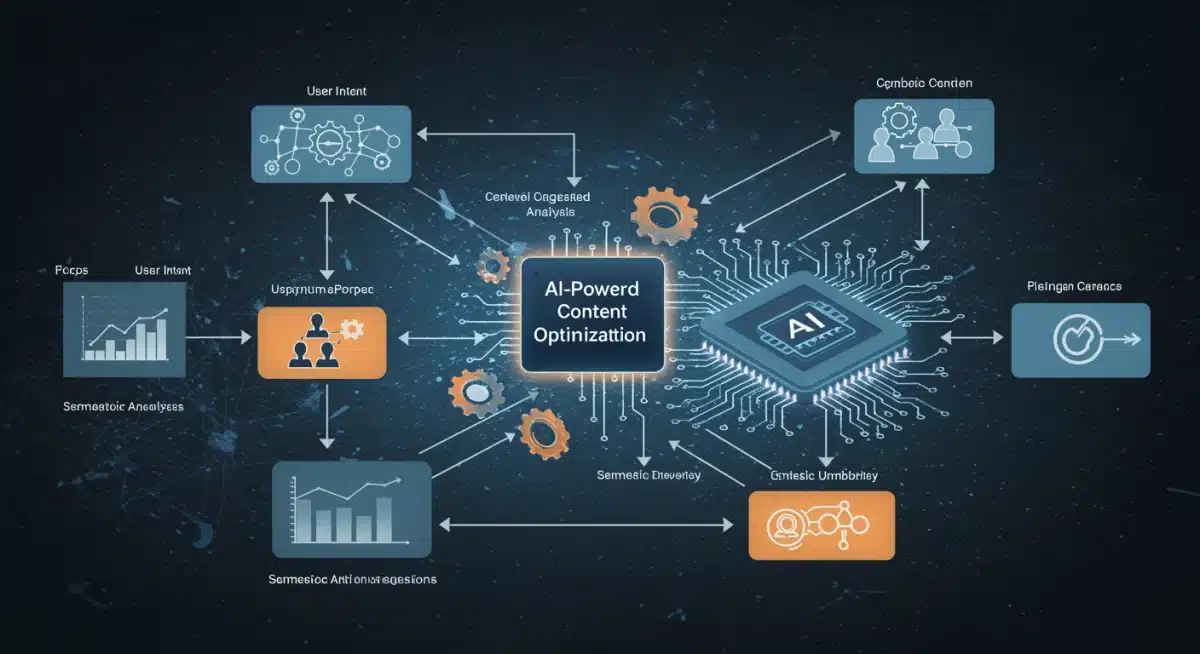Beyond Basic SEO: Advanced Techniques to Rank Top 3 Google 2025

The digital marketing sphere is currently experiencing a profound shift, making advanced SEO techniques crucial for securing a top 3 Google ranking by 2025, as insider knowledge reveals strategic pivots are imperative for sustained visibility.
The digital marketing landscape is in constant flux, and staying ahead means embracing innovation. For businesses aiming to achieve a coveted top 3 ranking on Google by 2025, moving beyond basic SEO: advanced techniques to rank in the top 3 on Google in 2025 (insider knowledge) are not just an advantage, but a necessity. This report unpacks the cutting-edge strategies and insights currently shaping the future of search visibility.
The Rise of AI and Machine Learning in SERP
The integration of Artificial Intelligence (AI) and Machine Learning (ML) is fundamentally reshaping how search engines, particularly Google, understand and rank content. As of early 2024, algorithms like RankBrain and MUM are not just processing keywords; they are interpreting context, user intent, and relationships between entities with unprecedented sophistication. This shift demands a more nuanced approach to SEO than ever before.
Understanding these AI-driven mechanisms is paramount. Google’s continuous updates, often unannounced, are increasingly focused on delivering hyper-relevant results by analyzing complex user behaviors and content quality signals. This means that a static keyword strategy is no longer sufficient for achieving top rankings.
Semantic SEO and Entity Optimization
Semantic SEO moves beyond individual keywords to focus on the meaning and relationships between concepts. Optimizing for entities—real-world objects, concepts, or persons—is now a critical component of advanced strategies, as Google’s algorithms better understand the world like humans do.
- Contextual Relevance: Ensure content addresses a topic comprehensively, covering related sub-topics and questions a user might have.
- Entity Salience: Clearly define and link to key entities within your content, helping Google understand the core subjects.
- Knowledge Graph Integration: Aim for inclusion in Google’s Knowledge Graph by providing structured data and authoritative information about your brand and topics.
Furthermore, the ability of AI to discern user intent has elevated the importance of truly valuable and comprehensive content. Pages that satisfy a user’s entire query, even implied ones, are seeing significant boosts in visibility. This requires a deep dive into audience psychology and advanced analytics.
Harnessing Predictive Analytics for Content Strategy
In the competitive realm of SEO, looking backward at data is no longer enough. Predictive analytics, utilizing historical data and machine learning models, is becoming a cornerstone for forecasting future search trends and user behavior. This proactive approach allows marketers to create content that anticipates demand, rather than merely reacting to it.
As reported by leading industry analysts, businesses leveraging predictive models are identifying emerging topics and keyword variations months in advance. This provides a crucial window to produce high-quality, authoritative content before competitors even recognize the trend. The advantage in securing early indexing and authority cannot be overstated.
Anticipating User Intent Shifts
User intent is dynamic, influenced by current events, technological advancements, and cultural shifts. Predictive analytics helps identify these subtle changes before they become mainstream, allowing for strategic content adjustments.
- Trend Forecasting: Use tools that analyze search patterns, social media discussions, and news cycles to predict upcoming content demands.
- Keyword Evolution: Monitor the semantic evolution of keywords, understanding how user language changes over time regarding specific topics.
- Content Gap Analysis: Proactively identify areas where future content demand will outstrip current supply, positioning your brand as a first-mover.
This forward-looking perspective is vital for maintaining a competitive edge. By anticipating what users will search for, brands can establish authority and relevance long before the competition catches up, solidifying their path to a top 3 ranking.
Core Web Vitals and User Experience as Ranking Factors
Google has consistently emphasized user experience (UX) as a critical ranking signal, and Core Web Vitals (CWV) remain at the forefront of this initiative. As of the latest updates in 2024, these metrics—Largest Contentful Paint (LCP), First Input Delay (FID), and Cumulative Layout Shift (CLS)—are more integrated into the ranking algorithm than ever before. Optimizing for CWV is no longer optional; it’s a fundamental requirement for advanced SEO techniques.
Sites that provide a seamless, fast, and stable browsing experience are demonstrably favored in SERPs. This extends beyond technical optimization to a holistic approach to site design and content delivery. A poor CWV score can negate even the most robust content and backlink strategies, pushing otherwise strong pages down the rankings.
Technical Optimization for Speed and Stability
Achieving excellent Core Web Vitals requires meticulous attention to technical details, from server response times to image optimization and script execution. These technical improvements directly impact how users perceive and interact with a website.
- Server Performance: Invest in high-quality hosting and Content Delivery Networks (CDNs) to minimize LCP.
- Resource Optimization: Compress images, lazy-load offscreen resources, and defer non-critical CSS/JavaScript to improve page load speed.
- Layout Stability: Ensure that elements on your page do not shift unexpectedly during loading, which can negatively impact CLS and user interaction.
Furthermore, mobile-first indexing and the increasing prevalence of mobile browsing mean that CWV performance on mobile devices is particularly crucial. A smooth mobile experience is a non-negotiable aspect of achieving and maintaining high rankings.
Leveraging E-E-A-T and Authoritative Content Production
Google’s emphasis on E-E-A-T (Experience, Expertise, Authoritativeness, and Trustworthiness) has intensified, becoming a foundational pillar for advanced SEO. As of 2024, content that demonstrates genuine experience, deep expertise, clear authoritativeness, and undeniable trustworthiness is consistently outperforming generic or poorly sourced material. This is particularly true for Your Money Your Life (YMYL) topics, where the stakes for accurate information are highest.
Brands and individuals aiming for top rankings must actively cultivate and showcase these E-E-A-T signals. This involves more than just writing well; it requires strategic content planning, transparent author attribution, and building a verifiable reputation within a niche. Google’s algorithms are increasingly adept at identifying and rewarding genuine authority.

Building and Showcasing E-E-A-T Signals
To establish strong E-E-A-T, content creators must think beyond basic keyword stuffing and focus on providing verifiable value and credibility. This involves a multi-faceted approach to content creation and promotion.
- Author Biographies: Prominently display author credentials, experience, and relevant affiliations.
- Source Citations: Back up claims with links to reputable sources, academic papers, and industry reports.
- Reputation Management: Actively seek and manage reviews, testimonials, and mentions from authoritative sites and figures.
The strategic development of thought leadership content, case studies, and original research also plays a significant role in demonstrating expertise and trustworthiness. Brands that position themselves as industry leaders through high-quality, verifiable content will find themselves increasingly favored by Google’s evolving algorithms.
The Strategic Importance of Zero-Click SERP Optimization
The phenomenon of zero-click search results, where users find their answer directly on the Google Search Engine Results Page (SERP) without clicking through to a website, is a growing trend. While seemingly counterintuitive for traffic generation, optimizing for zero-click SERPs is now a critical advanced SEO technique for brand visibility and establishing authority. As of the latest data, a significant percentage of searches result in no clicks, making direct SERP presence invaluable.
This means focusing on strategies that capture Featured Snippets, People Also Ask (PAA) boxes, rich snippets, and other SERP features. Appearing in these prominent positions not only enhances brand visibility but also reinforces expertise and trustworthiness, even if it doesn’t always lead to a direct website visit. It’s about owning the answer on Google’s own platform.
Capturing Featured Snippets and Rich Results
To dominate zero-click SERPs, content needs to be structured and optimized specifically for these features. This often involves providing concise, direct answers to common questions and using schema markup.
- Direct Answers: Structure content to provide clear, succinct answers to potential user questions, often in the form of definitions or step-by-step instructions.
- Schema Markup: Implement appropriate schema (e.g., FAQ schema, How-To schema) to help Google understand and display your content in rich results.
- Question-Based Content: Create dedicated sections or entire articles that directly address common questions, anticipating what users might ask.
Securing these zero-click features can significantly increase brand exposure and establish a brand as an authoritative source, even without a direct click. It’s a strategic move for long-term brand building and competitive differentiation.
Cross-Platform SEO and Omnichannel Presence
Modern advanced SEO extends far beyond organic web search. An omnichannel presence, integrating SEO efforts across various platforms—including YouTube, social media, voice search, and local listings—is increasingly vital for a top 3 Google ranking by 2025. Google’s algorithms now consider a brand’s overall digital footprint and authority across the web, not just its website’s performance.
This means that a holistic strategy involves optimizing content for different search environments and user behaviors. For instance, optimizing video content for YouTube search is as important as optimizing articles for Google Web Search. Similarly, a strong local SEO presence directly impacts how a brand appears in Google Maps and local pack results.
Integrating SEO Across Digital Touchpoints
Developing a cohesive cross-platform SEO strategy requires understanding the unique algorithms and user behaviors associated with each digital channel. Synergy between these platforms amplifies overall visibility and authority.
- Video SEO: Optimize YouTube titles, descriptions, tags, and transcripts for relevant keywords and topics.
- Social Media Signals: While not direct ranking factors, strong social engagement can drive traffic, build brand authority, and indirectly influence search rankings.
- Voice Search Optimization: Adapt content to answer conversational queries, focusing on long-tail keywords and natural language patterns.
By ensuring a consistent and optimized presence across all relevant digital channels, brands can build a robust digital ecosystem that Google increasingly recognizes and rewards. This integrated approach is a hallmark of advanced SEO techniques designed for future success.
| Key Technique | Brief Description |
|---|---|
| AI & Semantic SEO | Optimizing for context, entities, and user intent, leveraging AI-driven algorithms. |
| Predictive Analytics | Forecasting future search trends and user behavior to create proactive content. |
| Core Web Vitals | Ensuring superior user experience through optimized page speed and stability. |
| E-E-A-T & Authority | Building and showcasing verifiable experience, expertise, authoritativeness, and trustworthiness. |
Frequently Asked Questions About Advanced SEO
Semantic SEO focuses on the meaning and relationships between concepts, rather than just keywords. It’s crucial because Google’s AI-driven algorithms, like MUM, now interpret user intent and entity relationships, rewarding content that comprehensively addresses topics and their related sub-topics effectively.
Core Web Vitals (LCP, FID, CLS) are key user experience metrics that Google uses as direct ranking signals. Achieving excellent scores ensures a fast, stable, and smooth browsing experience, which is increasingly favored by Google’s algorithms for higher organic search positions, especially on mobile.
E-E-A-T (Experience, Expertise, Authoritativeness, Trustworthiness) is fundamental for establishing credibility with Google. Content that clearly demonstrates these qualities, particularly for YMYL topics, is consistently rewarded with higher rankings as Google aims to provide users with the most reliable information.
Optimizing for zero-click SERPs, such as Featured Snippets, increases brand visibility and establishes your authority directly on Google’s results page. While not always generating a click, it reinforces expertise and trust, making your brand the go-to source for information, crucial for long-term recognition.
Cross-platform SEO is vital because Google assesses a brand’s overall digital footprint. Optimizing for YouTube, social media, and voice search, alongside traditional web search, creates a cohesive omnichannel presence. This comprehensive approach amplifies overall visibility and builds authority across various digital touchpoints, influencing Google’s perception.
What Happens Next
As of late 2024, the trajectory for SEO is clear: a relentless march towards more intelligent, user-centric algorithms. Businesses and marketers not adapting to these advanced SEO techniques risk significant declines in visibility. The industry anticipates further integration of generative AI within search results, potentially altering how information is consumed. Expect Google to continue refining its E-E-A-T guidelines, placing even greater emphasis on genuine authority and verified experience. Monitoring algorithm updates closely and investing in continuous learning will be paramount for any entity aiming to secure and maintain a top 3 Google ranking by 2025 and beyond.





